Author: JUMPENG
Project Introduction
Centrifuge is a decentralized asset financing protocol that unlocks the liquidity of real-world assets, allowing borrowers to finance their real-world assets without banks or other intermediaries. Centrifuge connects real-world assets to DeFi to lower the cost of capital for small and medium-sized enterprises and provide DeFi investors with a stable source of income unrelated to volatile crypto assets. Tinlake is the investment application of Centrifuge, serving as an open market for real-world asset pools, where investors can view the funding pools provided by asset originators and invest in pools that suit them to generate returns.
Author
JUMPENG, Senior Researcher at Shiliang Research Institute. Master of Finance from Huazhong University of Science and Technology, with 7 years of industry experience, specializing in Layer1, DeFi, NFT, Layer2, Gamefi, and other fields, having researched over 2000 projects and produced over 500 in-depth research reports.
1. Research Highlights
1.1. Core Investment Logic
Rich ecological resources: Strong support from MakerDAO, strategic partnership with Aave. Centrifuge's greatest competitive advantage lies in its successful deep collaboration with most top DeFi projects, laying a solid foundation for rapid user aggregation and liquidity anchoring. Taking MakerDAO as an example, it has become the source of 80% of stable funding for Centrifuge's active loan amount, forming a positive cycle: MakerDAO obtains high-quality collateral assets through Centrifuge, and the massive funding support drives explosive growth in Centrifuge's business. This win-win model allows Centrifuge to efficiently unlock and utilize real-world assets. In addition to MakerDAO, Centrifuge has also partnered with top DeFi projects such as Aave to jointly build RWA-exclusive funding pools, bringing more platform traffic and user dividends to the Centrifuge ecosystem. It can be foreseen that relying on such a strong ecological alliance, Centrifuge's leading position in the RWA track will be more solid, which is its greatest core competitive strength.
Strong team at Centrifuge: Centrifuge was founded in 2017 by three co-founders, Lucas Vogelsang, Maex Ament, and Martin Quensel. All three are professionals in the blockchain and finance industries with extensive industry experience. The entire Centrifuge team has now grown to about 56 people, covering multiple fields such as blockchain, finance, legal regulation, and more. This team of professionals is the solid backing that enables Centrifuge to operate smoothly, playing a crucial role in technology development, business operations, asset management, risk control, and more. This also sets it apart in the competitive RWA track, representing another major competitive advantage for Centrifuge.
Unique technological implementation at Centrifuge: Compared to traditional collateralized lending, the RWA industry faces higher technical challenges in public chain governance and asset valuation, which places higher demands on the project's research and development capabilities. As a technological pioneer in the RWA industry, Centrifuge has conducted extensive exploration and practice in these areas. It has independently developed Centrifuge Chain, an RWA-optimized blockchain, achieving scalable and low-cost transaction settlement. In terms of core asset valuation mechanisms, Centrifuge has designed a unique risk adjustment model that can finely reflect the default losses of different asset classes. Additionally, it has achieved multi-level securitization of asset collateral, effectively dividing investment risks. These technologies represent pioneering practices in the entire industry. It can be said that Centrifuge has already achieved a leading level of mastery in RWA technology, laying a solid foundation for its future product iterations and business expansion. This "technological barrier" advantage also makes it difficult for competitors to surpass.
1.2. Valuation
As of November 24, 2023, Centrifuge's current circulating market value is approximately $208 million, with a TVL of about $258 million, indicating room for growth in valuation. At the same time, comparing the TVL and FDV data of credit protocols such as Maple, GoldFinch, Credix, and TrueFi, Centrifuge is in a leading position. From this perspective, Centrifuge's current valuation level is reasonable. Considering its leading position in the RWA field and greater potential for future growth, its valuation may be underestimated. Additionally, the value transmission opportunities of the CFG token economy model are increasing, and there are prospects for expansion into multi-chain and compliance consulting services, indicating potential for investment valuation space.
1.3. Project Risks
The project risks of Centrifuge mainly manifest in the valuation and authenticity of real-world assets, lack of infrastructure and high threshold risks, difficulty in avoiding off-chain risks, and uneven development of RWA track projects, as detailed in the SWOT analysis section of the report.
2. Project Overview
2.1. Project Introduction
Centrifuge is a decentralized open-source financial platform dedicated to realizing the on-chainization of real-world assets. Through the application of blockchain technology, it addresses the pain points of insufficient asset liquidity in traditional finance. Centrifuge allows individuals or institutions with real-world assets to use these assets as collateral for financing on-chain. Unlike traditional finance, this financing model does not require credit ratings or complex approval processes, and the entire process is open and transparent, without the need to trust third-party institutions. On the other hand, Centrifuge also provides a new choice for investors seeking stable returns. They can provide liquidity for collateralized financing by purchasing Senior and Junior tokens in Centrifuge's liquidity pool and receive pool revenue dividends, allowing investors to obtain stable returns insulated from crypto market volatility through Centrifuge. Overall, Centrifuge addresses the issue of insufficient liquidity of real-world assets, effectively connecting traditional business activities and blockchain finance, injecting new development momentum into the real economy, and its model's security and efficiency have been validated by the market.
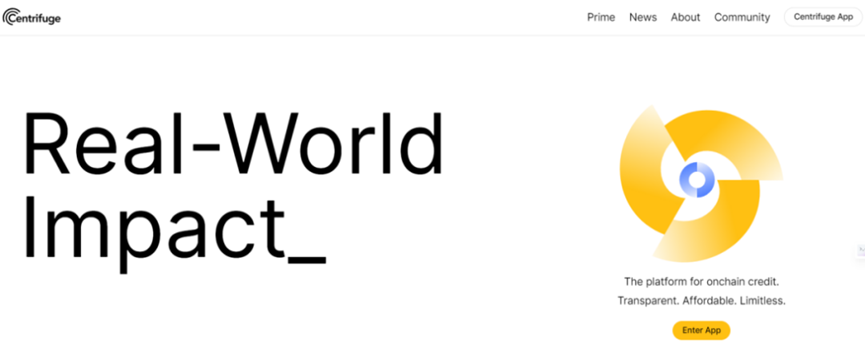
Source: Centrifuge official website homepage
2.2. Team Overview
2.2.1. Overall Situation
Centrifuge was founded in 2017 by Lucas Vogelsang, Maex Ament, and Martin Quensel. According to LinkedIn, the team currently consists of 56 people. One of the co-founders, Maex Ament, has long been engaged in the traditional supply chain finance field and has many years of industry experience. Software engineer Alina Sinelnikova graduated from the Massachusetts Institute of Technology and has many years of development experience. Other core members have strong professional capabilities in traditional finance and technical development.
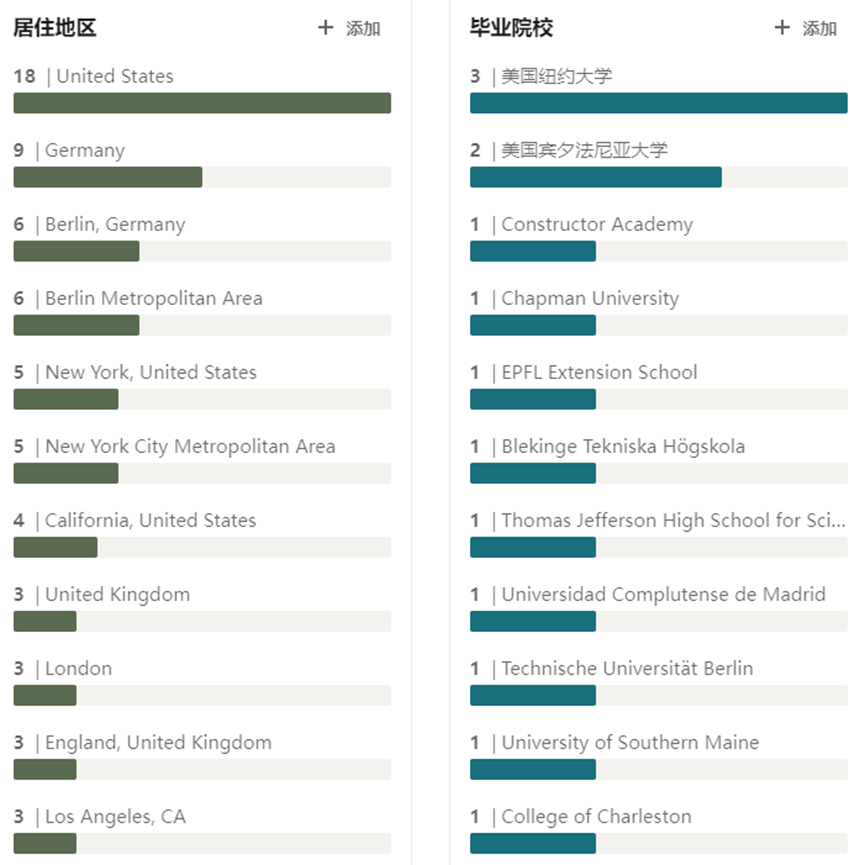
Source: LinkedIn official website
2.2.2. Core Members
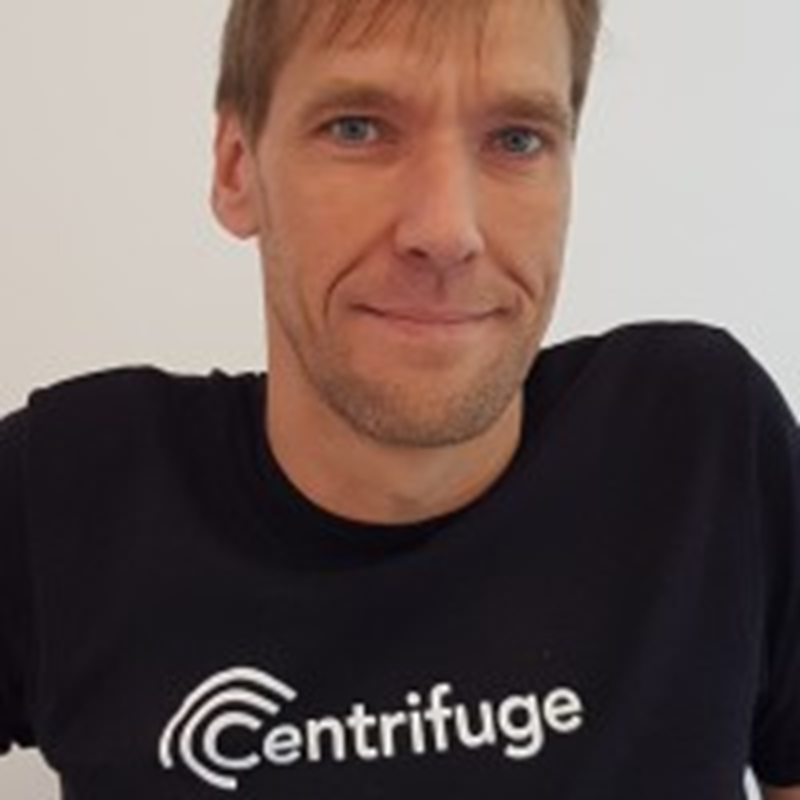
Martin Quensel: Martin Quensel is a co-founder of the Centrifuge project, and this is the fourth startup he has founded and managed. He has over 20 years of rich experience in the finance and IT industries. In the early days, Martin founded and managed the first supply chain software company called M+M Software, which primarily provided supply chain management software solutions and was later acquired by industry leader SAP. After leaving M+M Software, Martin co-founded the leading financial supply chain management software company Taulia with other partners. He served as the CEO of Taulia and successfully developed Taulia into a global leader in the field during his 8-year tenure as CEO. In 2015, Taulia completed a $144 million financing, marking its success. After leaving Taulia, Martin focused on new technological innovations in the financial services sector and founded Centrifuge, an enterprise financing project based on blockchain technology. Centrifuge is the fourth startup company founded and managed by Martin Quensel. He brings rich management experience and technical vision to the Centrifuge project and has in-depth research on the application of blockchain technology in the financial services sector. Currently, in addition to Centrifuge, Martin also serves as a board member of several blockchain startups and is also a limited partner in a well-known blockchain financial investment institution.
Lucas Vogelsang: Lucas Vogelsang is a co-founder and CEO of the Centrifuge project, and is also responsible for managing Centrifuge's technical development team. Prior to joining Centrifuge, Lucas was responsible for technical research and product architecture in multiple startup teams for a long time, with over 10 years of experience in the IT and programming fields. Initially, Lucas was responsible for developing mobile applications at a startup, helping clients with data mining and analysis. He then joined an internet service company, where he was responsible for designing and building service-oriented web frameworks. Through these work experiences, Lucas accumulated rich experience in software development management. He is skilled at communicating with development teams and defining the technical direction of products. He is also an excellent programmer himself, familiar with various programming languages and development approaches. Leveraging this technical background, Lucas joined Martin in envisioning and creating the Centrifuge project. As the CEO of Centrifuge, Lucas is responsible for the project's daily operations and technical development management. He uses his technical vision and years of management experience to lead the development team in realizing the vision of using blockchain technology to optimize enterprise financing processes at Centrifuge. Lucas actively explores the prospects of blockchain in the financial services sector.
2.3. Financing Situation
According to disclosed information, Centrifuge has completed 5 rounds of financing, raising a total of over $31 million. Investors include top VCs such as Coinbase Ventures, IOSG Ventures, and partners such as BlockTower. Overall, the strong VC lineup has brought abundant resources in terms of products, funds, compliance, and more to Centrifuge.
According to Crunchbase and RootData, on March 6, 2018, Centrifuge completed a $4.3 million financing. On October 29, 2019, Centrifuge completed a $3.7 million financing.
On February 23, 2021, Centrifuge completed a $4.3 million financing, with Galaxy Digital and IOSG leading the investment, and Rockaway, Fintech Collective, Moonwhale, Distributed Capital, TRGC, and HashCIB participating.
On May 27, 2021, Centrifuge conducted a CFG token sale on CoinList, with two options for the token sale. Option one's sale period was from May 26 at 17:00 UTC (1:00 on May 27 Beijing time) to May 31 at 14:00 UTC (22:00 Beijing time), with a price of $0.55 per token, and the tokens would unlock on July 14, 2021. Option two's sale period was from May 26 at 23:00 UTC (7:00 on May 27 Beijing time) to May 31 at 14:00 UTC (22:00 Beijing time), with a price of $0.38 per token, and the tokens would be linearly released over two years. The single address purchase limit for both options was $500, and the supply limit was 17 million tokens. In addition, Centrifuge would provide a whitelist for its lending DApp Tinlake users, selling a total of 6.375 million tokens, which would unlock over two years. According to official information, this public offering raised over $15 million.
On November 2, 2022, Centrifuge completed a $4 million financing, with participation from Coinbase Ventures, BlockTower, Scytale, and L1 Digital, among others. BlockTower and MakerDAO will create a $220 million fund on Centrifuge.
On October 16, 2023, the Web3 Foundation announced the 19th batch of grant funding, providing a total of approximately $1.1 million in grants to 33 projects, with Centrifuge being selected.
2.4. Past Development and Roadmap
2.4.1. Past Development
Date
Event
May 27, 2020
Project launched, introduced the Ethereum-based lending Dapp Tinlake
February 23, 2021
Completed a $4.3 million financing, led by Galaxy Digital and IOSG
September 29, 2021
Altair, the first parachain on the Kusama network
January 29, 2022
Won the 8th parachain slot auction on Polkadot
March 31, 2022
Released roadmap: to start and expand real-world asset pools
April 6, 2022
Successfully migrated to the Polkadot parachain
July 1, 2022
Launched the hybrid cross-chain solution Centrifuge Connectors
November 2, 2022
Completed a $4 million financing, with participation from Coinbase Ventures, among others
September 8, 2023
Aave community proposal to collaborate with Centrifuge Prime for RWA investment and allocate $1 million USDC
September 19, 2023
Centrifuge liquidity pool testnet to be launched on Arbitrum and Base
2.4.2. Development Plans and Roadmap
Based on current information, Centrifuge's future development roadmap may include the following aspects:
A. Completion of mainnet migration: Centrifuge plans to migrate Tinlake and other core businesses to its independently developed blockchain, Centrifuge Chain, in 2023 to increase the use cases of CFG. This can further reduce gas costs and improve business performance.
B. Launch of Institutional Consulting Services: In order to attract more institutional clients, Centrifuge also plans to launch compliance and consulting services for institutions. This can help institutional clients establish standardized solutions in necessary legal requirements, business processes, etc., reducing their entry barriers.
C. Cross-chain Deployment and Expansion: Centrifuge also plans to deploy its business on other public chains such as Avalanche in the future. This will rely on the advantages of each chain's own users, funds, etc., to rapidly expand the project's scale. It is foreseeable that Centrifuge will become a leading brand in cross-chain RWA services.
In summary, Centrifuge is actively expanding its business scope, enhancing the application scenarios of CFG, and advancing cross-chain layout, which will help it become a standard provider of RWA infrastructure.
2.5. Social Media Data
As of November 20, 2023, Centrifuge has been active on social media, gaining widespread attention. Its main operating channels include Twitter and Discord. Centrifuge has over 66,538 followers on Twitter, with frequent updates, making it the primary promotional channel. The specific data for each platform is as follows:
Media Channel
Discord
Telegram
Medium
Number of Followers
66,538
15,177
2,812
\
Online/Active
Frequent updates
1,007
Frequent updates
\
3. Project Analysis
3.1. Project Background
The background of the Centrifuge project mainly consists of two aspects: the origin of the project and the current growth challenges in the DeFi market.
1) Birth Background
Centrifuge was born from the team's years of accumulated practical experience. The founding team previously jointly created and operated the enterprise-level supply chain financial services platform Taulia, providing convenient and efficient supply chain financing support to the world's top 2000 enterprises. Through long-term operational practice, they clearly realized that although Taulia had helped small and medium-sized enterprises reduce funding costs, these enterprises still faced many financing obstacles. Specifically, small and medium-sized enterprises cannot directly access open liquidity resources and must rely on the traditional banking system, bearing its high intermediary costs. At the same time, the lack of an open and transparent trading venue also affects their ease of access to funding. The project team realized that by using blockchain technology to create an open online financing platform, it would help provide lower-cost financing channels for small and medium-sized enterprises, enabling them to better play their role in the economy.
2) Development Background
Today, while DeFi has made significant progress, it is difficult to continue to grow solely relying on the cryptocurrency project itself. RWA, as a new track connecting the real economy, is highly anticipated. However, RWA projects are difficult to implement, with high entry barriers, requiring professional service providers to be responsible for rule compliance and technical support. Centrifuge is precisely an RWA infrastructure service provider that integrates compliance and technology.
3.2. RWA Overview
3.2.1. Definition of RWA
RWA (Real World Assets) refers to real-world assets, and in general, all tokenized assets from the offline real world can be represented by RWA. Different from the securitization of assets that bridges traditional assets and capital markets, the essence of RWA tokenization is to build a bridge between the real economy and decentralized finance, injecting on-chain liquidity into tangible assets. The underlying supported asset types of RWA are diverse, including stocks, bonds, real estate, art, and other tangible assets, as well as cash, accounts receivable, and other intangible assets. All of these real-world assets, even fiat currency, can be tokenized and proven on-chain. Currently, the stablecoin USDT, which occupies the third place in the cryptocurrency market value, can be said to be the most successful RWA, mapping the US dollar to the chain and tokenizing it.
3.2.2. Operation Mechanism of RWA
The core of RWA lies in the on-chain representation of off-chain assets, allowing them to enter the decentralized financial system and enjoy liquidity benefits. Its basic operating process can be summarized into the following three key steps:
A. Financialization of Off-chain Assets: This requires a clear understanding of the economic attributes of assets, including asset pricing, ownership confirmation, legal compliance audits, etc., laying the foundation for asset tokenization.
B. Trusted On-chain Financial Data: Through technical means such as oracles, the on-chain and off-chain data are connected, allowing smart contracts to obtain key data such as asset prices in real-time, ensuring the reliability of on-chain prices. Additionally, encryption technologies such as zero-knowledge proofs are used to protect the privacy and security of data.
C. Token Issuance for Asset Tokenization: The corresponding protocol issues tokens or NFTs representing asset ownership to the market and investors. Investors participate in the income and liquidity of assets by purchasing and circulating these tokens.
It can be seen that the most difficult part of RWA in operation is not the on-chain process, but rather the pre-on-chain and post-off-chain processes. Native on-chain data is transparent and trustworthy, but there may be fraudulent activities in bridging off-chain assets to the chain, and the liquidation of off-chain asset collateral is much more complex than that of on-chain collateral. How to handle these issues and bridge the gap between on-chain and off-chain is the key to the success of the RWA mechanism.
3.3. Project Principle
Centrifuge has built an original business model that effectively connects real-world assets with DeFi. It achieves the fine design of asset financing through both on-chain and off-chain aspects:
A. Off-chain Part: Using the SPV mechanism, SPV (Special Purpose Vehicle) is a special legal entity whose function is generally to purchase, package securitized assets, and issue asset-backed securities based on them in the process of offshore asset securitization, mainly for investment. Because the business scope is strictly limited, it is generally a high credit-rated entity that is unlikely to go bankrupt. The SPV mechanism establishes a dedicated legal entity for each financing to isolate borrowing risks and protect investor rights.
B. On-chain Part: It mainly includes three aspects: P2P network, structured pool, and legal structure.
● P2P Network: Centrifuge uses the peer-to-peer network principle to help asset issuers securely upload data to the chain as NFTs, ensuring the authenticity of financing and providing necessary details to investors through private off-chain data to supplement asset pricing needs.
● Use of Structured Pool: Using structured products such as DROP and TIN, it perfectly decomposes financing risks and returns to meet different investment preferences. This lowers the threshold compared to direct P2P models, allowing more institutions to participate.
● Legal Structure: Centrifuge also integrates a legal framework of best compliance practices, allowing more users to participate in the platform through KYC-compliant and trustworthy means.
In simple terms, Centrifuge, as a lending platform, is primarily about connecting two parties: those who want to earn income through lending, mainly DeFi protocols in the crypto field, such as MakerDAO, Aave, etc., and those who want to finance, generally startups or organizations with real-world assets such as real estate, accounts receivable, invoices, etc. To bridge the flow of assets between the real world and DeFi, Centrifuge needs to provide legal and on-chain support. The "real asset financial asset token" model proposed by Centrifuge, with both technical and legal aspects, effectively achieves interoperability between on-chain and off-chain financing ecosystems, providing a more efficient financing channel for small and medium-sized enterprises.
3.4. Technical Architecture
3.4.1. Centrifuge Chain
Centrifuge Chain is an L1 chain independently developed by Centrifuge, used to create dedicated infrastructure for on-chain representation of real-world assets. The chain is developed based on the Substrate framework and can share the security protection of the Polkadot network. In January 2022, Centrifuge Chain successfully won the 8th parachain slot auction of Polkadot.
Compared to general-purpose smart contract public chains, Centrifuge Chain has significant advantages in transaction performance and scalability. It provides dedicated block space for processing RWA transactions, significantly reducing gas fees. Additionally, it can customize transaction logic to ensure the priority sequence of RWA transactions, addressing congestion issues. This allows Centrifuge to better achieve the digitization and circulation of real-world assets.
1) Asset Tokenization and Private Data Sharing
To transform real assets into on-chain representations, Centrifuge adopts NFT tokenization. Each borrower issues a unique NFT, which contains the basic asset information required for tokenization. These NFTs are locked in the Centrifuge asset pool, representing the corresponding assets and used for financing. However, the publicly released NFT information on-chain typically only includes basic fields, which may not meet investors' demand for more comprehensive asset data. Centrifuge has designed a solution with a private data layer.
A. The private data layer adopts a peer-to-peer network of POD nodes, allowing issuers and investors to securely share additional data assets in this network. Asset data, after being hashed, is anchored in the on-chain NFT, achieving verifiable correlation without the need to disclose the data itself.
B. Through the private data layer, participating parties can flexibly choose who can access which asset information fields. For example, institutional investors can access more comprehensive data, while third-party assessment agencies can only read and write specific data, effectively combining asset tokenization with the demand for private data.
2) On-chain Securitization
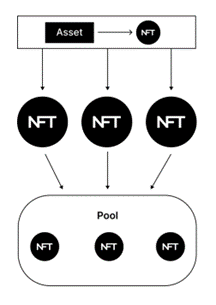 Providing financing separately for various real-world assets is not efficient, so Centrifuge adopts a centralized securitization strategy to address this issue. After assets are tokenized, they are centrally managed in the asset pool through NFTs, and investors provide funds for the entire pool, while issuers finance individual assets, gradually repaying investors. This creates a single source of asset details - the blockchain, providing transparent financial accounting for investors. Unlike decentralized databases, the information is publicly available and trustworthy. Additionally, based on risk preferences, Centrifuge adopts a tranching structure (detailed in the next section). This diversified mechanism lowers barriers, attracting a wider range of users to allocate assets, while centralized management also improves operational efficiency, passing on the reduced financing costs to users.
Providing financing separately for various real-world assets is not efficient, so Centrifuge adopts a centralized securitization strategy to address this issue. After assets are tokenized, they are centrally managed in the asset pool through NFTs, and investors provide funds for the entire pool, while issuers finance individual assets, gradually repaying investors. This creates a single source of asset details - the blockchain, providing transparent financial accounting for investors. Unlike decentralized databases, the information is publicly available and trustworthy. Additionally, based on risk preferences, Centrifuge adopts a tranching structure (detailed in the next section). This diversified mechanism lowers barriers, attracting a wider range of users to allocate assets, while centralized management also improves operational efficiency, passing on the reduced financing costs to users.
3) Integration with DeFi
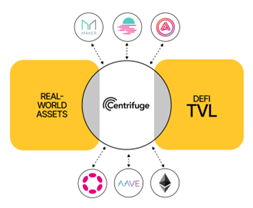 Centrifuge designs its asset pool to support direct integration with any EVM chain, greatly reducing the complexity of integrating DeFi protocols with it. Through standard interfaces, DeFi products such as stablecoin protocols can directly invest in Centrifuge's asset pool, providing deeper liquidity support for issuers. This eliminates the difficulties many DeFi projects face in integrating various sources of liquidity and their respective user bases.
Centrifuge designs its asset pool to support direct integration with any EVM chain, greatly reducing the complexity of integrating DeFi protocols with it. Through standard interfaces, DeFi products such as stablecoin protocols can directly invest in Centrifuge's asset pool, providing deeper liquidity support for issuers. This eliminates the difficulties many DeFi projects face in integrating various sources of liquidity and their respective user bases.
Centrifuge Chain itself is based on the Substrate framework and supports multi-chain interaction. This means that projects participating in the ecosystem are not limited to the same chain and can work together across different networks, forming a truly multi-chain open financial ecosystem. Overall, Centrifuge's design allows its asset pool to be conveniently and efficiently accessed and participated in by DeFi products, greatly reducing the difficulty of integrating DeFi with real assets, promoting deep integration between the two, benefiting asset issuers and the entire industry.
4) Legal Structure
Centrifuge has done considerable work in compliance based on the legal structure of asset securitization in the United States. Its legal structure is based on Section 506(b) or 506(c) of the 1933 U.S. Securities Act.
Every asset originator on Centrifuge needs to establish an independent legal entity corresponding to the fund pool, known as a Special Purpose Vehicle (SPV). SPVs can play a crucial role in asset securitization, separating the business of the asset originator from the financing activities in the pool. It only provides a conduit and has no employees. Legally, these assets have been sold to the SPV, so even if the asset originator goes bankrupt, it will not affect the assets held by the SPV, thus protecting the interests of investors. After completing KYC and other compliance operations, investors enter into agreements with the SPV.
The current legal structure is developed for issuing asset securitization products in the United States. For U.S. citizens, investment in this product must meet the requirements of the U.S. SEC for "accredited investors." Centrifuge is also working to introduce product structures for non-U.S. jurisdictions, but currently, countries under U.S. sanctions cannot invest in Centrifuge's products.
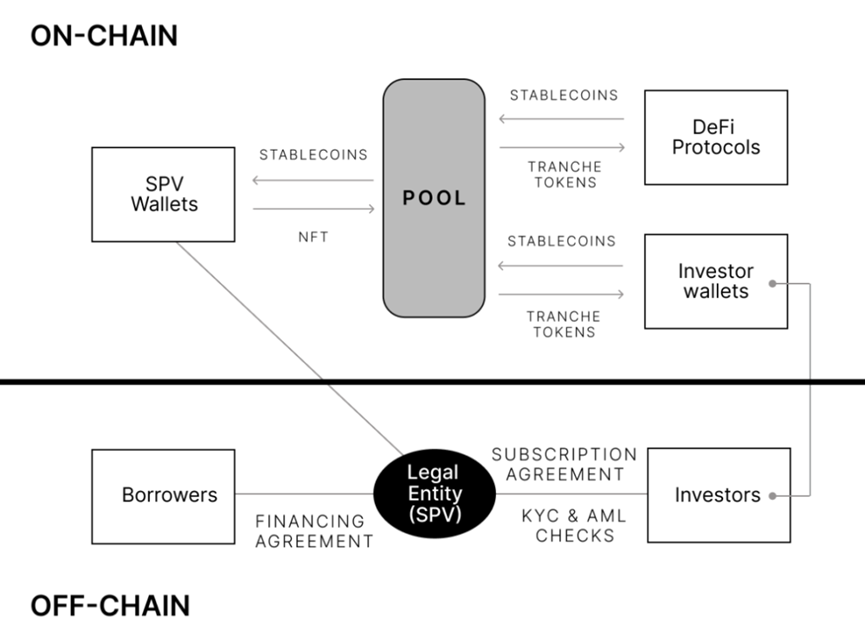
Source: Centrifuge official documentation
3.4.2. Tinlake
Tinlake is an open-source decentralized lending platform deployed by Centrifuge on Ethereum, serving as the main product gateway for customer-oriented applications and is a consumer-facing product. It transforms real-world assets (such as invoices, collateralized loans, and royalties) into ERC-20 tokens, which enter the liquidity pool as collateral for financing, allowing borrowers to obtain stablecoin loans with physical assets as collateral. In simple terms, Tinlake is a smart contract-based open asset pool that connects asset originators with investors, providing liquidity for enterprise financing through DeFi.

Source: Centrifuge official documentation
1) Tranche Investment Structure
Tinlake adopts a tranching structure to meet different investment preferences, finely dividing the risks and returns of the asset pool to provide users with diverse participation methods. It typically includes senior, junior, and mezzanine tranches. The senior portion is for investors seeking stable returns, the junior portion is for investors with risk preferences, and the mezzanine portion is set between the senior and junior, offering a balance of return security and potential income. Currently, the on-chain Ethereum pool implements a two-layer solution, referred to as DROP and TIN for the senior and junior levels, respectively.
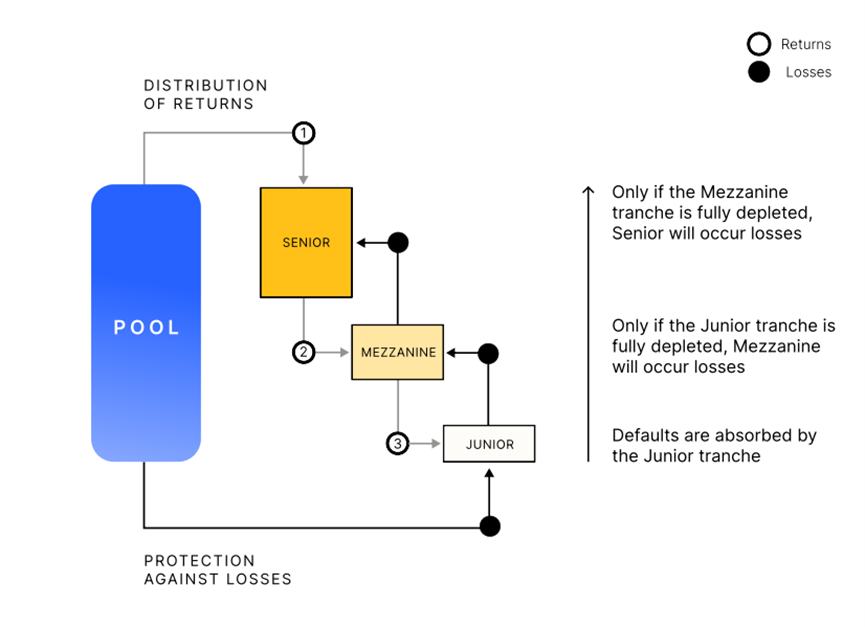
Source: Centrifuge official documentation
A. Senior Yield Class DROP Token - Low Risk, Low Return
In the Tinlake asset pool, the DROP token represents a higher-priority role - the senior portion. Investors holding DROP tokens will receive fixed and stable returns prioritized in the asset pool profit distribution. This is because the DROP token is designated as the "senior" role, ranking above the junior TIN token. Its return rate is fixed and stable, and in the event of default losses in the asset pool, the risk will be borne by the TIN token, and DROP holders do not need to bear the initial losses in the asset pool. In other words, the DROP token enjoys the privilege of priority profit and default risk protection, making it stable in returns and relatively low in risk. Compared to the TIN token, the DROP token typically provides a safer investment option for investors, which is an important reason for the positioning of DROP as a "senior" product.
B. Junior Yield Class TIN Token - High Risk, High Return
Unlike the DROP token, the TIN token, as the junior portion product in the Tinlake asset pool, represents the floating interest portion in the asset pool. The TIN token has a lower priority in the asset pool profit distribution compared to the DROP token, but at the same time, it also bears higher risk. Especially if there are default losses in the asset pool, this risk will be borne by the TIN token. Due to the higher risk of bearing initial losses, the TIN token typically offers investors a variable, uncertain, but potentially higher return investment option. It faces greater risk than the DROP token, but also has the opportunity to provide investors with returns greater than fixed returns when the asset pool's returns exceed expectations. In short, as the "junior" role, the TIN token is more variable in both risk and return compared to the DROP token, providing investors with a higher-risk but potentially higher-return investment choice.
In Tinlake, investors can choose to purchase DROP or TIN tokens based on their risk tolerance and return expectations. The TIN token has a minimum subscription ratio, and if the TIN ratio is too low, the DROP token cannot continue to be purchased. Additionally, the Tinlake pool is set as a "revolving" pool or open pool, allowing investors to join or exit at any time, and the funds provided by investors can be reallocated by the asset originator (unless investors redeem).
2) Revolving Pool
Tinlake adopts a revolving pool design, allowing investors to invest/redeem at any time. Taking into account investors' preferences (such as the risk indicator in the Drop pool being lossless), the decentralized resolution mechanism matches investment and redemption behaviors. This ensures that asset originators have a stable source of liquidity, while investors can flexibly invest and redeem.
3) Epochs - Investment and Redemption
Centrifuge uses the Epochs mechanism to coordinate various fund inflows and outflows from investors and borrowers, ensuring the balanced operation of the fund pool.
A. Each Epoch lasts at least 24 hours, and investors can invest and redeem at any time during an Epoch. These investment and redemption requests are locked by the system and automatically executed at the end of the current Epoch based on risk indicators and priority.
B. If not all orders can be executed due to fund pool liquidity reasons, the system will initiate a resolver mechanism. This mechanism aims to maximize investor rights while executing as many orders as possible. Anyone can submit a solution to the system.
This periodic execution mechanism effectively responds to various fund change requests, ensuring the smooth operation of the fund pool. It provides flexibility for investors and stable liquidity sources for asset originators.
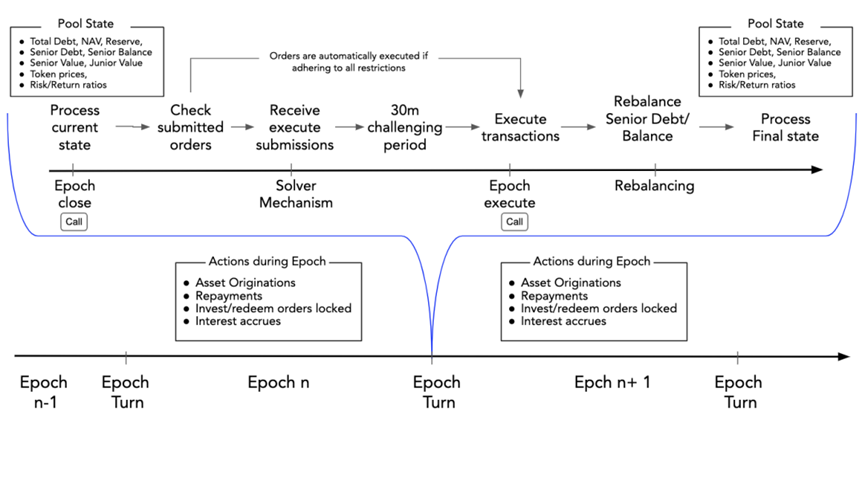
Source: Centrifuge official documentation
4) Centrifuge Prime
Tinlake is currently operating on the Ethereum mainnet, but there are plans to migrate all operations to Centrifuge Chain, and related functionalities have been validated on the chain's testnet. As the business develops, Centrifuge is actively advancing a more secure and user-friendly upgraded product to replace Tinlake, which will continue to provide foundational support for RWA business. In June of this year, Centrifuge announced the launch of Centrifuge Prime, an RWA infrastructure product developed by Centrifuge, which is a comprehensive set of services and technologies that can help DeFi native organizations (such as DAOs, stablecoins, and protocols) easily join and expand their investment portfolios with real-world assets (RWA). Its toolkit includes: a compliance legal framework built for DAOs and DeFi protocols, a complex tokenization and issuance platform, decentralized and objective credit risk and financial reporting, and diverse asset categories and issuers. In August of this year, Aave passed a proposal to invest in U.S. bonds through cooperation with Centrifuge Prime.
3.5. Project Roles
The Centrifuge network mainly consists of four types of roles: originators, asset originators, investors, and compliance parties.
1) Originators
Originators are Special Purpose Vehicles (SPVs) corresponding to Centrifuge fund pools. These SPVs are independent legal entities that issue senior and junior tokens representing the asset pool to obtain financing. The SPV provides the financing to real-world borrowers, corresponding to Centrifuge's asset pool. The SPV operates independently and has independent legal status, effectively isolating the credit risk of the parent company.
2) Asset Originators
Asset originators link real-world assets to Centrifuge smart contract pools. They maintain business relationships with borrowers and are responsible for conducting due diligence and legal compliance on real-world collateral assets (such as invoices, property loans, etc.), and tokenizing these assets through Centrifuge's technical framework. Asset originators also participate in investments in the junior portion to demonstrate risk acceptance of the assets they originate.
3) Investors
Investors refer to participants who provide liquidity to Centrifuge fund pools. After completing KYC, investors can choose to purchase senior or junior tokens. Senior tokens have lower risk and stable returns, while junior tokens have higher risk and greater fluctuation in returns. Investors earn returns and CFG mining rewards by providing liquidity for these tokens.
4) Compliance Parties
Compliance mainly refers to the KYC and AML work carried out by Centrifuge in collaboration with third-party compliance institutions. This includes real-name and identity authentication of investors, as well as anti-money laundering monitoring. Currently, Centrifuge mainly completes these processes through collaboration with the compliance company Securitize, which helps Centrifuge pools comply with legal requirements and attract more institutional investors.
3.6. Project Process
The general process of financing is usually as follows:
1) Establish SPV and Complete Legal Asset Segmentation
First, the asset originator will establish an SPV (Special Purpose Vehicle) for each fund pool. The SPV is an independent legal entity that separates collateral assets from the originator's other business to reduce credit risk exposure. Then, the relevant parties will sign a series of legal documents to clearly delineate ownership, usage rights, and profit rights of the assets.
2) Asset Originator Tokenizes Real Assets into NFTs as Collateral
The asset originator will use the Centrifuge Chain and P2P messaging protocol to upload real-world asset-related data to the chain and generate NFTs as the unique identifier for the asset on the chain. The NFT will then be locked in the Tinlake smart contract on Ethereum as collateral.
3) Issuance of DROP and TIN Tokens for NFT Collateral
Tinlake will issue DROP and TIN tokens for the collateral financing based on the locked NFT and rating model, representing ownership of different risk and return portions in the financing.
4) Investors Purchase Tokens to Provide Liquidity for the Asset Pool
After completing KYC identity verification, investors can choose to purchase the high-risk but high-return TIN tokens or the low-risk but stable-return DROP tokens to provide liquidity for the asset pool.
5) Borrowers Repay Funds and Convert to Stablecoins for Redemption
At maturity, borrowers need to repay the financing principal + interest. The on-chain operation will unlock and return the collateral NFT. The repaid funds will be exchanged by the smart contract into stablecoins for investors to redeem their tokens.
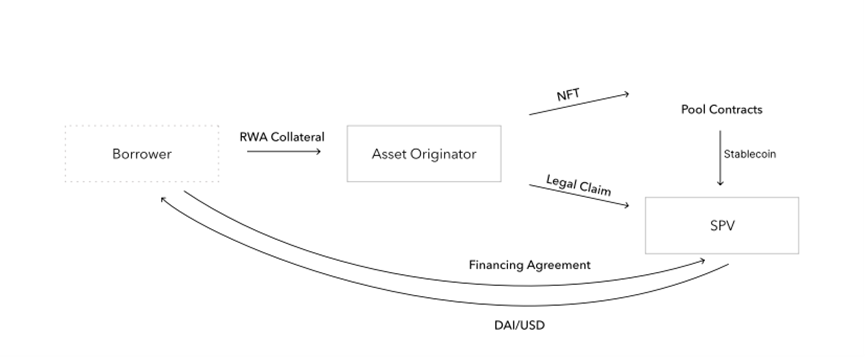
Source: Centrifuge official documentation
3.7. Project Data
According to information displayed on the official website, Centrifuge currently has 16 fund pools, with a total of 35 senior and junior tokens, reaching a total TVL of $246.096 million.
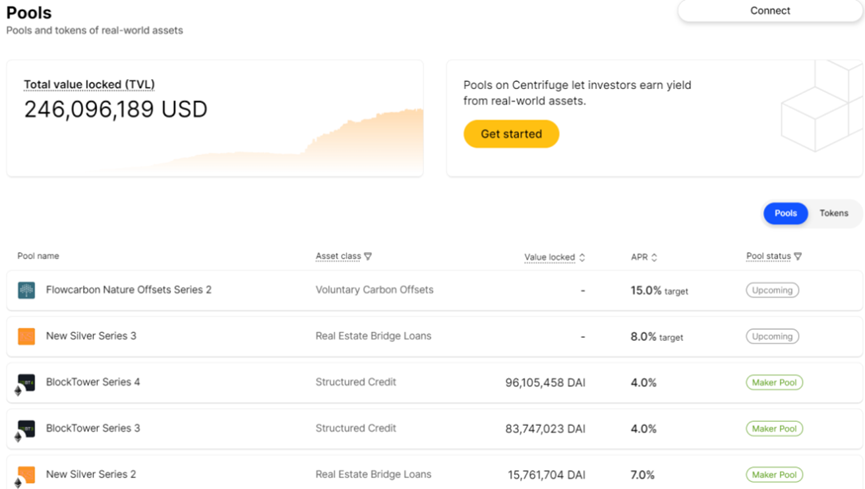
Source: Centrifuge official website
Users can directly connect their wallets to complete KYC and sign agreement documents before choosing a pool to invest in. The pools currently use DAI and USDC, with the BlockTower Series 4, co-built by Centrifuge and MakerDAO, having the highest deposit, with 961.05 million DAI deposited and an APY of around 4%. Other products accept DAI deposits, with APY ranging from 4% to 8%. Staking in Tinlake also provides a 3.13% CFG reward.
3.8. Project Ecosystem
Centrifuge has built a comprehensive RWA business ecosystem covering compliance, technology, and funding. At the technical level, Centrifuge has connected real-world assets with leading DeFi projects such as MakerDAO and Aave, creating a win-win situation.
1) MakerDAO Boosts Centrifuge as a Leader in On-Chain Credit
Among the major DeFi protocols, MakerDAO and Aave are actively engaged in RWA business, which is facilitated through Centrifuge. Centrifuge is an early on-chain lending protocol, emphasizing lending against traditional real-world assets, making it one of the earliest players in RWA. As early as 2020, Centrifuge, as a technology service provider, helped MakerDAO build an RWA vault for 6s Capital's real estate development collateralized loans. The rapid growth of on-chain lending in Centrifuge this year is mainly attributed to MakerDAO's layout in RWA assets.
2) MakerDAO-Related Pools
Out of the 16 lending pools disclosed on the Centrifuge official website, 8 are related to MakerDAO. For example, the New Silver series, which invests in real estate bridge loans, the BlockTower series, which invests in structured credit, and the Harbor Trade Credit series, which is based on accounts receivable lending, all have MakerDAO as a senior investor in the pools. Currently, the funds related to MakerDAO in the pools amount to approximately $200 million, accounting for about 80% of Centrifuge's total TVL (approximately $250 million).
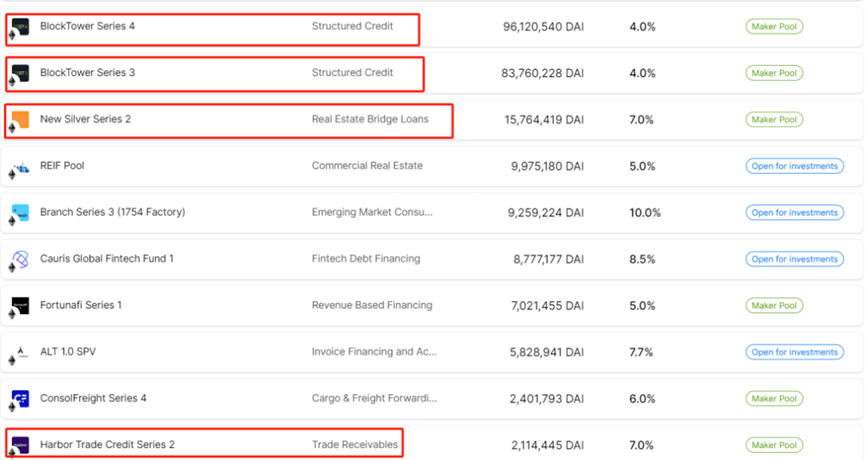
Source: Centrifuge official website
According to MakerBurn data, the BlockTower S3 and BlockTower S4 vaults integrated with Centrifuge, both established this year, have provided approximately $57 million and $65 million in DAI supply, respectively, up to now. This means that MakerDAO has provided Centrifuge with over $120 million in loan funding support this year.
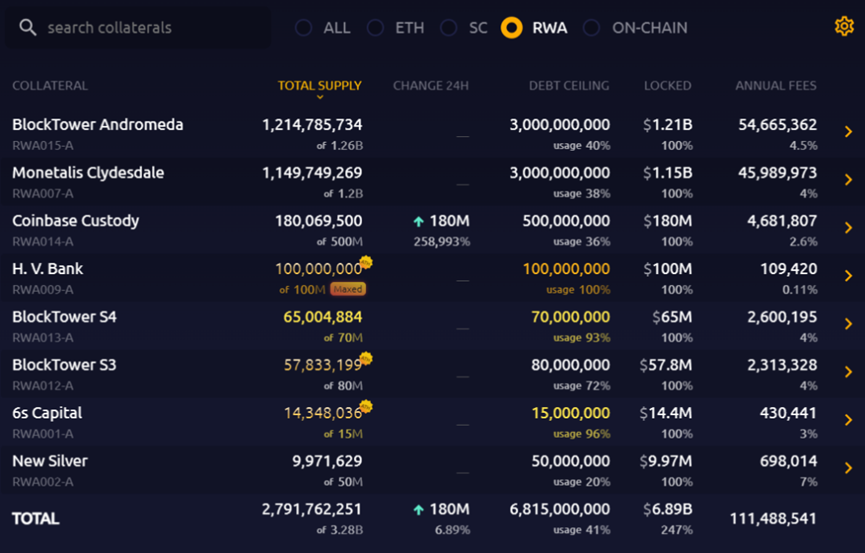
Source: MakerBurn
3) Collaboration with Aave
Aave and Centrifuge have jointly established a lending pool dedicated to RWA. Depositors can deposit USDC and, in addition to earning interest income, also receive mining rewards from Centrifuge. Borrowers can use various DROP tokens as collateral to borrow USDC, increasing the utilization of funds. The total deposits in the RWA market in Aave are currently $7.62 million, with USDC deposits at $3.41 million and total borrowings at $2.78 million, which is not high compared to MakerDAO.
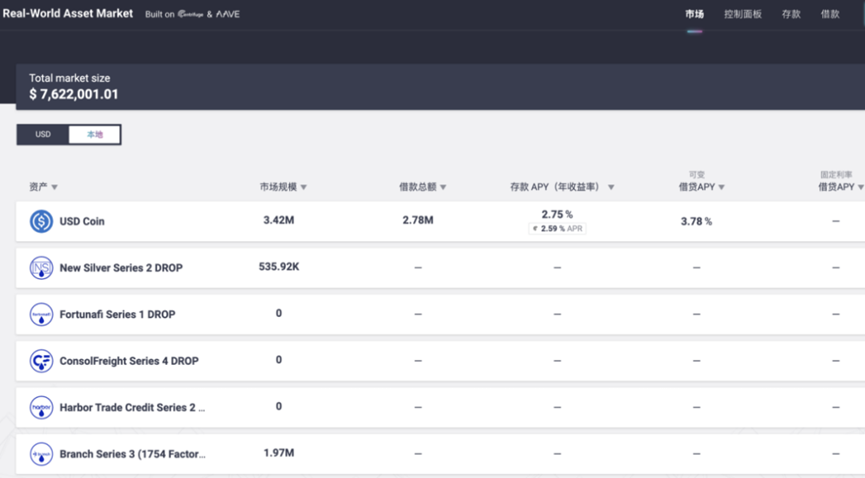
At the business level, Centrifuge collaborates with third-party KYC, rating, and auditing institutions to provide services for asset evaluation, investor onboarding, and compliance circulation, forming a complete support system. This reduces the business costs of DeFi organizations and enhances the adaptability of RWA assets in the DeFi scene. It is foreseeable that Centrifuge will further expand its cooperation and attract more DeFi organizations and institutional funds. The widespread demand for RWA assets in DeFi will also support the securitization of more high-quality real-world assets on-chain.
4. Race Space and Potential
4.1. Overview of the Race
4.1.1. Race Positioning
Centrifuge belongs to the RWA (Real World Asset) race, specifically the private credit segment within the RWA race.
4.1.2. Race Scale
Although the RWA market is still in its early stages, it has shown a strong momentum of rapid growth. According to DeFiLlama statistics, as of the end of November 2023, the total locked value (TVL) of RWA in various DeFi categories has risen to sixth place, up four places from its tenth position six months ago, indicating significant growth momentum. It is understood that in the past six months, with the acceleration of tokenization applications for US Treasury bonds and other mainstream assets, the TVL scale has continued to increase, demonstrating the increasing market demand as new projects continue to emerge and traditional financial asset on-chain applications mature. The RWA race has gradually entered a period of rapid development, especially with the significant effects brought about by the tokenization of mainstream assets, which will continue to elevate the position of RWA in the DeFi ecosystem in the long term.
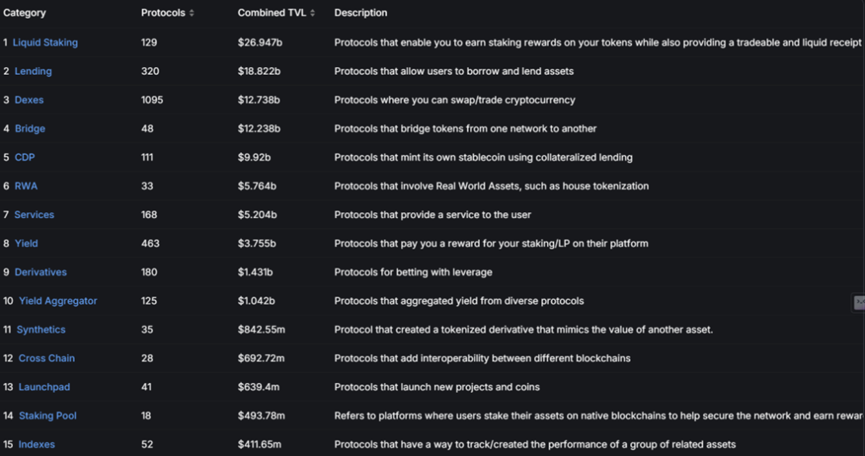
Source: DeFiLlama
Specifically, the current crypto market mainly relies on on-chain activities to generate income, lacking stable and sufficiently diverse real income sources. The rise of RWA can fill this gap. RWA can continuously introduce new liquidity and users to the crypto market, providing diverse, asset-backed stable income. These real-world collateral assets also bridge the gap between the crypto market and traditional finance through DeFi, driving the widespread application of digital assets. According to research by BCG and ADDX, the tokenization market for illiquid assets globally could reach $16 trillion by 2030, close to 10% of the global GDP at that time. Even with market environment changes, the most conservative estimate still leaves a space of $3.5 trillion. In comparison, the total market value of the entire cryptocurrency market is only about $1.2 trillion, considering the total global asset value of $900 trillion, the potential for RWA tokenization is still enormous. If the RWA industry can capture about 1% of the traditional financial asset market share, it would mean adding approximately $9 trillion in new liquidity and real income sources to the DeFi system. This not only brings financial and user dividends to the crypto market but also drives the digital upgrade of traditional finance, with its potential impact on the market being revolutionary.
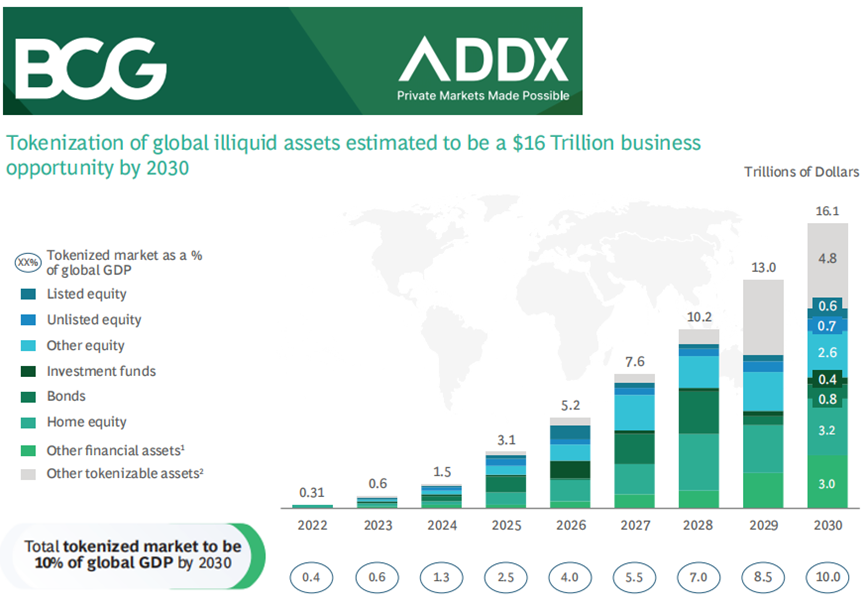
Source: New BCG report: Asset tokenization projected to grow 50x into a US$16 trillion opportunity by 2030
Additionally, according to Coingecko data, as of November 23, the total market value of RWA tokens exceeded $1.2 billion, which is approximately 1/50 of the market value of DeFi tokens, indicating significant potential for growth in the RWA race.
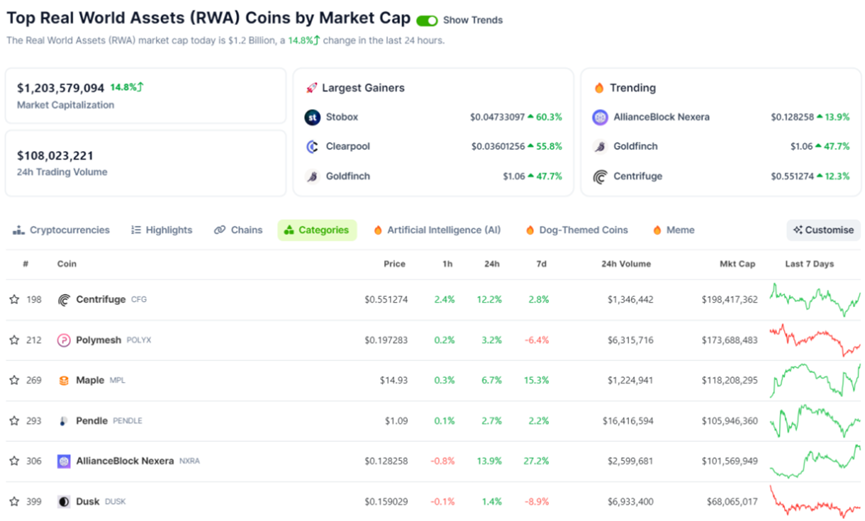
Source: Coingecko
4.1.3. Race Landscape
1) RWA Race Landscape
Due to the broad definition of RWA, the RWA race involves a wide variety of project types, including Layer1, stablecoins, lending, real estate, public bonds, carbon credit trading, and more, with over 60 specific projects in various categories. The following is a brief introduction to each specific category:
A. Stablecoins: This is the earliest and largest area to adopt the RWA concept, including mainstream stablecoins such as USDT and USDC.
B. Private Credit: These projects use collateral and rating models to achieve risk stratification, with Centrifuge being a standout project in this category.
C. Public Bonds: Leading DeFi projects like MakerDAO have made significant investments in highly liquid public bonds to generate stable returns. Representative projects include Ondo Finance and BondbloX.
D. Stocks/Private Equity: Some tokenization projects for compliant stocks and fund tokens have been launched, but the scale is still relatively small. Representative projects include Backed and Swarm.
E. Real Estate/Carbon Credits: The tokenization of high-value, low-liquidity assets is steadily progressing. Representative projects include Propy and Toucan.
F. Precious Metals/Collectibles: Some stablecoin projects support the issuance of tokens backed by assets such as gold, and the provenance of collectibles is also being traced using blockchain technology. Representative projects include Codex Protocol and PAX Gold (PAXG).
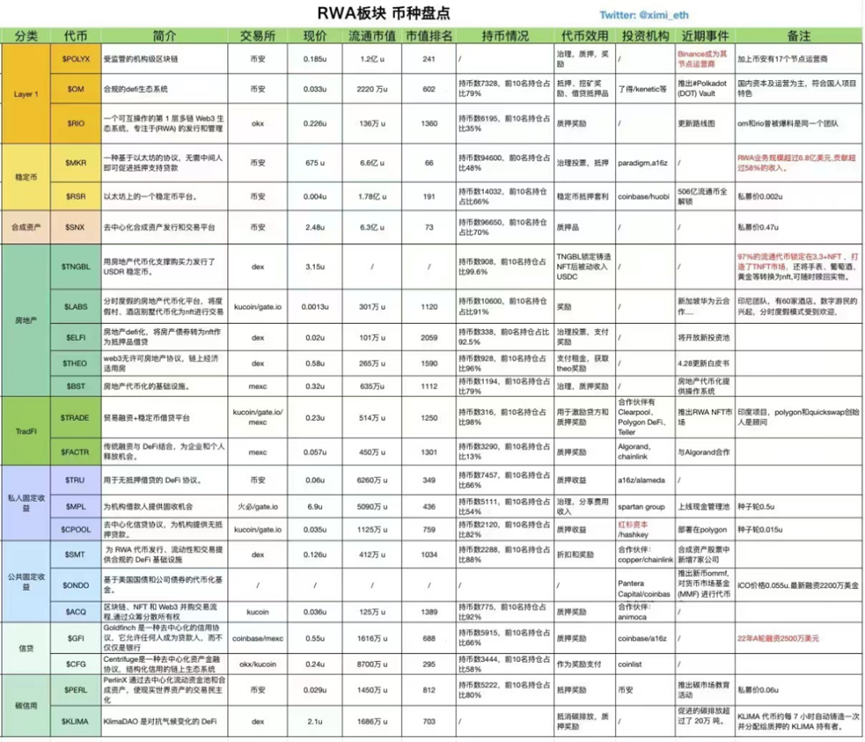
Source: @ximi_eth
In addition, there are some infrastructure projects in the RWA space that may not belong to a specific RWA category. These include Layer 1 blockchains such as Polymesh, a permissioned blockchain specifically designed for RWA tokens; MANTRA Chain, built on the Cosmos SDK to allow users to issue and trade RWA tokens; Realio Network, focused on the issuance and management of RWA tokens; Provenance, built on the Cosmos SDK to enable financial institutions to issue and trade financial asset tokens; and Intain, focused on financing and credit. Overall, RWA is more widely applied in stablecoins, bonds, and stock-like assets, with increasing applications in real estate, carbon credit certificates, art, precious metals, and other areas. Maker, a leading DeFi project, has already invested $700 million in RWA.
2) Private Credit
Based on the aforementioned race landscape classification, Centrifuge belongs to the private credit subcategory within the RWA race. We will now analyze this subcategory in detail. Private credit is an important part of the RWA race. According to data from rwa.xyz, the total loan volume in this field has reached approximately $4.7 billion, mainly serving small and medium-sized enterprises in emerging countries. These enterprises have gained additional financing support outside the traditional financial system through the democratized services of on-chain lending platforms. However, from the data, it is evident that the current participants in on-chain private credit are mainly institutions and large enterprises, with total loans amounting to several billion dollars and only over a thousand loan transactions. The significant demand for large-scale credit in some African and Asian countries is the main driving force at present. These phenomena indicate that there is still significant room for improvement in the liquidity and participation of RWA assets in the private credit field. With the opening of regulatory environments and continuous project optimization, ordinary investors will also have more opportunities to share in this rapidly growing market.
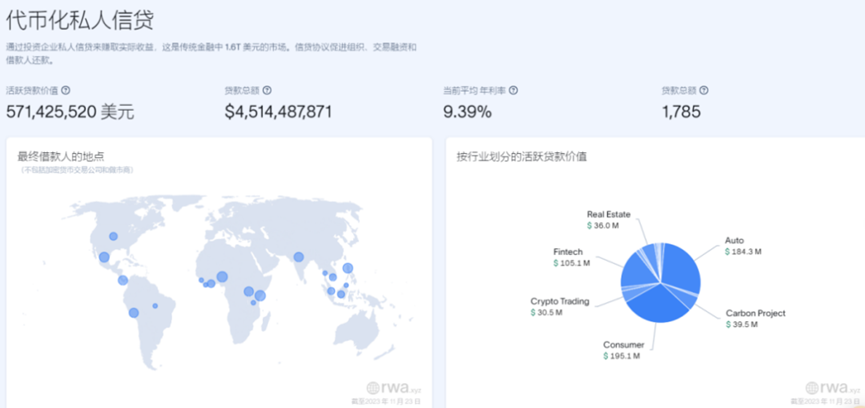
Source: rwa.xyz
Looking specifically at the protocols for private credit, on-chain lending has grown by 84% this year, adding approximately $350 million from January 1 to November 23, with Centrifuge accounting for 70% of this growth. Several leading on-chain lending protocols from a year ago have now diminished significantly in 2023, with Maple, which once claimed nearly $1 billion, being one example. However, Maple is the second-largest contributor to the growth of on-chain lending, with its active loan value increasing by only about $60 million as of the third quarter.

Source: rwa.xyz
4.2. Competitive Analysis
4.2.1. Core Competitive Factors
A. TVL Scale: TVL is an important indicator reflecting the attractiveness of project funds and the effectiveness of ecosystem construction. A higher TVL indicates that the RWA project has attracted more customers and funding support, and the ecosystem construction is more effective.
B. Team Strength: RWA projects require professionals in multiple fields such as research and development, finance, and operations. The team's integration capabilities in technological innovation, business expansion, and asset operations directly impact the project's development potential.
C. Institutional Penetration: Obtaining recognition and support from leading DeFi organizations and institutions is beneficial for RWA projects to quickly accumulate liquidity and users. This reflects the project's brand effect and trustworthiness.
D. Token Economic Model: Tokens should have sufficient application scenarios and value capture space. This can create strong economic incentives and enhance the risk resistance of tokens and their protocols.
The competitiveness determined by the comprehensive consideration of the above factors determines the market position and future prospects of RWA projects.
4.2.2. Competitive Analysis
Based on the analysis of the private credit sector mentioned above, this section conducts a competitive analysis of Centrifuge with four influential projects in the credit sector: Maple, GoldFinch, Credix, and TrueFi.

Source: rwa.xyz
1) Maple
Current total loans: $18.086 billion, active loans: $139 million, default loans: $48.85 million, token market cap: $105 million.
Maple integrates the traditional CLO financial model into the blockchain to guide more enterprises to obtain on-chain funding.
It establishes relationships with financial institutions and enterprises, acting as the first loss provider and independently evaluating enterprise loan requests. This results in a strong centralization, with the decision-making power in the hands of the Maple team. Currently, 62% of the active loan amount has been handed over to its 11 investment company representatives, which may increase its overall risk. In addition, Maple's default rate is 2.935%, especially considering the share held by the 11 companies, the credit quality also needs to be observed. Overall, Maple fully exploits the convenience of blockchain for enterprise financing, but its risk management capabilities and the decentralization of its financing model need to be strengthened, which will affect the platform's long-term stability.
2) GoldFinch
Current total loans: $1.13 billion, active loans: $1.03 billion, default loans: $5 million, token market cap: $44.88 million.
GoldFinch is a decentralized protocol for unsecured lending. It establishes a unified senior asset pool, ensuring that all participants face the same risks, and the pool's responsibilities and return rates remain consistent, with borrower risks managed through diversification across different types and industries. GoldFinch has a fully decentralized decision-making mechanism, with project financing and scale collectively decided by supporters. Its leverage model and incentive mechanism allow highly supported borrowing pools to receive more capital support. So far, the project has performed well, with a low default risk, thanks to its innovative credit assessment mechanism and unified fund management mechanism. Overall, GoldFinch achieves true decentralization in unsecured lending through technological reform. Its credit management and liquidity design can provide inspiration for the industry.
3) Credix
Current total loans: $44.02 million, active loans: $35.53 million, no default loans, no tokens.
Credix aims to create a credit ecosystem for institutional borrowers and investors. It adopts a centralized structure, with a team responsible for managing various aspects of the investment process. It designs non-transferable tokens separately for each market, which may hinder liquidity. At the same time, strict requirements may also block some investors. As a remedy, Credix sets up a three-tier default prevention mechanism for senior assets, including additional collateral and support from internal funds for subordinate guarantees. Overall, Credix explores blockchain reform of the credit model, but its centralization and strict design limit the breadth of participation, and the effectiveness of the remedial mechanism design needs to be observed in operation. While seeking further optimization of compliance and openness, it needs to mitigate certain concentration risks to enhance future operational potential.
4) TrueFi
Current total loans: $1.738 billion, active loans: $19 million, default loans: $4.43 million, token market cap: $48.88 million.
TrueFi is an unsecured lending protocol under the TrustToken ecosystem, collectively managed by users holding TRU tokens. It adopts a precise but centralized architecture, with the investment manager responsible for deciding loan projects, but it does not clearly outline a default plan. Currently, TrueFi has a low default rate, but this mainly depends on the quality of individual manager decisions. It has not fully utilized the advantages of blockchain, such as using on-chain credit information to improve credit assessment. Compared to other projects, TrueFi performs consistently in KYC compliance and transparent information disclosure. However, its unsecured model carries higher risks, and its liquidity management is relatively simple. Overall, TrueFi has yet to fully leverage the potential of blockchain technology, and its default mechanism and level of decentralization urgently need improvement, which will determine whether it can truly become a mature decentralized credit product. It needs to integrate more technological elements and delve deeper into on-chain information to achieve sustainable mechanism design.
4.2.3. Competitive Advantages
Based on the previous analysis and considering Centrifuge's network characteristics, a competitive advantage analysis of Centrifuge is conducted from the perspective of the core competitive factors mentioned above. As a pioneer in the RWA race, Centrifuge's business model and technological architecture are highly representative. Below is a brief analysis of the differences between Centrifuge and projects such as Maple and GoldFinch:
A. Centrifuge adopts a dual-layer on-chain and off-chain architecture, which can better manage compliance risks, while most competitors rely more on centralized institution audits.
B. Centrifuge supports collateralization of various types of real-world assets, while the collateral asset types of its competitors are relatively single.
C. Centrifuge has implemented senior and junior tokenization, dividing risks, while only GoldFinch has adopted a similar senior asset pool design among similar projects.
D. Centrifuge has a higher credit default rate, which is a result of its business model and not a signal of failure. In comparison, Maple and GoldFinch have more mature default controls.
E. Centrifuge is committed to building RWA infrastructure and has close cooperation with multiple leading DeFi projects, which is its greatest competitive advantage.
Overall, as a technological pioneer, Centrifuge has accumulated rich experience in the on-chain tokenization of RWA assets. This makes it an ideal partner for many DeFi projects, and this advantage is difficult for competitors to surpass in the short term.
4.3. Token Economic Model Analysis
4.3.1. Token Total Supply and Distribution
1) Token Information
Token symbol: $CFG
Market ranking: 180
Current price: $0.657
Current market cap: $235,684,664
24-hour trading volume: $2,038,217
Fully diluted market cap: $292,432,668
Circulating supply: 360,263,043
Total supply: 447,006,951
It is worth noting that 81% of CFG's circulating supply accounts for the total supply, indicating that the majority of the tokens are already circulating in the secondary market, and there is not much selling pressure from the project team or institutions.
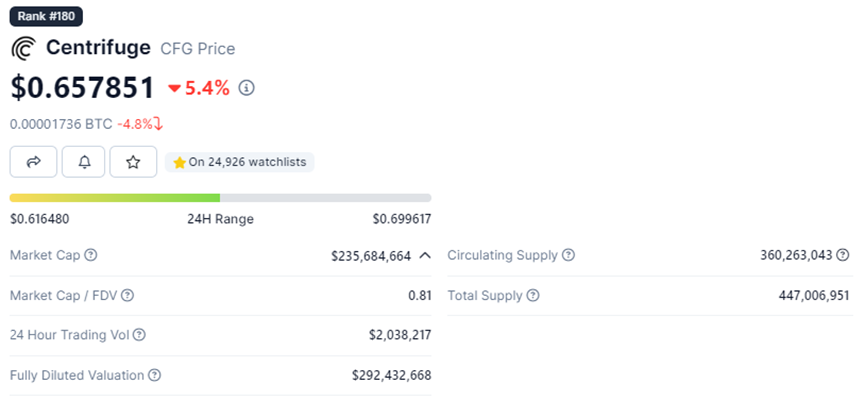
Source: Coingecko
2) Token Secondary Market Performance
According to data from Coingecko, the current price of CFG is $0.66, which is more than 4 times higher than the approximately $0.15 at the beginning of the year. However, it still has a significant gap compared to the record of over $2 during the bull market in 2021.
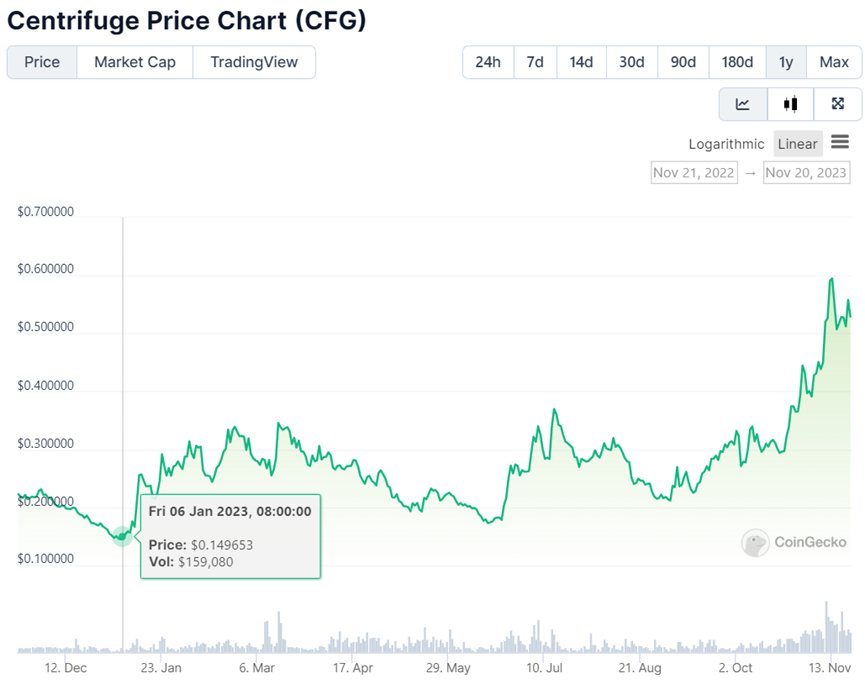
Source: Coingecko
3) Initial Distribution of CFG Tokens
The initial issuance of Centrifuge network's native token CFG was 4 billion, and this token distribution was implemented by the Centrifuge Foundation. In addition, as the Centrifuge network went live, an additional 50 million CFG was minted on top of the initial issuance for on-chain security incentive rewards to reward participants in network operation and maintenance.
According to early network snapshots, the overall supply of CFG tokens in the Centrifuge network is 425 million. This distribution ratio and mechanism ensure widespread distribution of tokens in the initial stage, laying a good foundation for the participant structure of network operation, which also aligns with Centrifuge's design philosophy of decentralization.
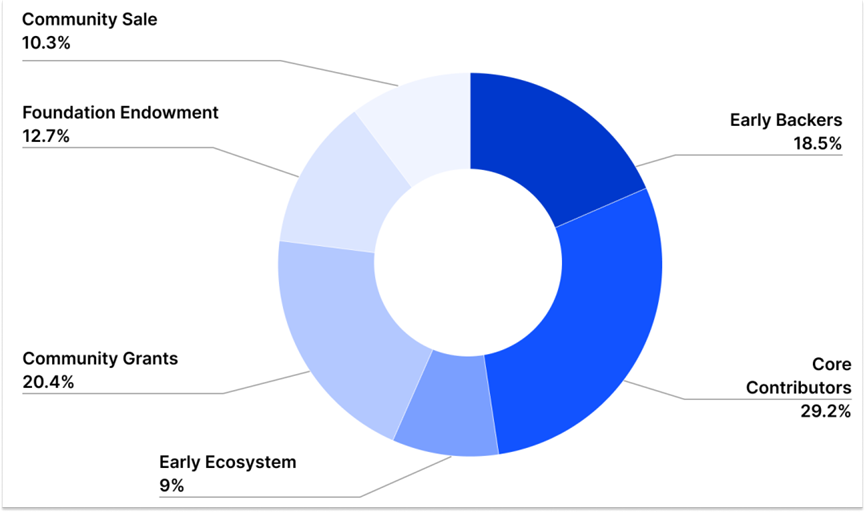
Source: Centrifuge Official Website
4.3.2. Core Demand for Tokens
A. Centrifuge Chain Validators: CFG is the native token of the Centrifuge Chain, and running the Centrifuge Chain network requires CFG as gas fees. Additionally, becoming a validator requires staking a certain amount of CFG, making validators an important demand factor for CFG.
B. Centrifuge Chain Governance Participants: CFG holders can participate in the decentralized governance of the Centrifuge Chain through locking and voting with CFG. Governance matters include parameter adjustments, upgrade plans, and issuance mechanisms, thus the sharing of governance rights also drives the demand for CFG.
C. Tinlake Users: In Tinlake and other Centrifuge products, users can obtain loan eligibility and priority usage rights by pledging CFG. Additionally, purchasing and using Tinlake also requires paying CFG fees, making this an important use case for CFG.
D. Liquidity Providers: Some exchanges and liquidity platforms incentivize liquidity provision through CFG mining, enhancing the circulation of CFG. This part of CFG liquidity comes from miners and traders.
Overall, the demand for CFG stems from participants in the Centrifuge system. As the business scales, the usage scenarios for CFG will become more diverse, and the demand will continue to grow.
4.4. SWOT Analysis
4.4.1. Project Strengths
Project strengths detailed in section 1.1 Core Investment Logic
● Rich ecosystem resources: Strong support from MakerDAO, strategic partnership with Aave.
● Strong team: Comprised of blockchain and finance professionals.
● Comprehensive regulatory framework: Emphasis on compliance to protect investor rights.
● Centrifuge's unique technological implementation.
4.4.2. Project Weaknesses
Lack of infrastructure and KYC and compliance are passive requirements for customers. Even though we know there are many advantages to using blockchain, the handling of each lending case involving real-world assets and different jurisdictions affects lending risk. Settlement of RWAs and other financial and compliance services in the real world is time-consuming and expensive, making it difficult for RWA projects to achieve scalable growth in the short term. Additionally, existing KYC and compliance services are more for legal compliance and are not truly linked to the security of customer funds, making it difficult for the RWA industry to attract more non-institutional individual users. The potential for development in the RWA industry is enormous, but there are currently issues with unclear regulatory policies and inadequate infrastructure, which are obstacles to the rapid advancement of projects. As a typical pioneer, Centrifuge must also address these systemic challenges; otherwise, its long-term development may be affected, which is the main threat faced by Centrifuge and the entire RWA ecosystem.
Valuation and authenticity of real-world assets: For most real-world assets, market trading is not frequent, making it difficult to determine fair value. This presents a significant challenge for asset valuation in RWA projects. Additionally, the project has implemented a unique risk-adjusted asset valuation model, but it still faces the risk of valuation deviations and data falsification. Once significant overvaluation or data falsification occurs, it will severely harm investor interests. Therefore, the fairness and authenticity of asset valuation are significant risks that Centrifuge must address. This is also a common issue in the entire RWA industry. Centrifuge must fully address this risk through technology and institutional means, such as introducing third-party audit mechanisms and using privacy computing technology to protect data authenticity. Otherwise, the smooth and sustainable entry of physical assets into the DeFi's vision will be difficult.
4.4.3. Project Opportunities
Broad prospects for the RWA industry: There is enormous potential for the transformation of traditional finance. This is not just a good business, but a huge one. Real-world finance is much larger than DeFi, and the decentralized world is still in its early stages compared to traditional industries. Even if a small part of traditional finance shifts to blockchain, it will be a huge success for DeFi and its infrastructure. The rise of RWA fully exploits the imbalance in the global financial system. In many emerging countries, the public and small and medium-sized enterprises face a lack of financial services, creating broad growth opportunities for RWA-type on-chain credit projects. These projects can leverage the decentralized advantages of blockchain technology to bridge the gaps in the financial system and provide convenient financing channels for more ordinary users. It can be foreseen that as more real-world assets are tokenized, the impact brought by Centrifuge will be even more profound.
New opportunities brought by cross-chain technology: Multi-chain deployment expansion can tap into more public chain ecosystems. Blockchain technology is rapidly evolving from the era of single chains to the era of cross-chains. This brings new opportunities for Centrifuge—through cross-chain technology, it can more easily access more public chain ecosystems and collaborate with leading DeFi projects on different chains, achieving interconnection. On one hand, this is beneficial for Centrifuge to further reduce transaction costs and improve system performance. On the other hand, it allows it to leverage the traffic advantages of different chains, expanding the project's influence and user base. As cross-chain technology continues to mature, in the future, users will not only be able to use Centrifuge on Ethereum, but also access its services on more chains such as Avalanche, BSC, and others. This will undoubtedly multiply Centrifuge's market space. It can be foreseen that the further development of cross-chain technology will drive the entire blockchain industry into a new pattern of multi-chain coexistence and inter-chain collaboration. At that time, cross-chain capabilities will become a necessary strategic layout for projects, which is the direction that Centrifuge is actively expanding into.
4.4.4. Project Threats
Uneven Development of RWA Projects: In the current RWA space, stablecoins and bonds, among other leading projects, far exceed the scale of other branches, creating a structural imbalance that increases systemic risks for the entire industry. If there is a change in the macro environment and decentralized financial markets regain momentum, the attractiveness of these mainstream RWA projects may significantly decline. If there is not strong support from other growth points, the entire RWA market will face the dilemma of confidence and capital withdrawal. As a pioneer in RWA technology and applications, Centrifuge must confront this potential threat. It needs to continue innovating in product iterations, expand the application scenarios of RWA models, diversify asset types, and broaden its user base. Only by forming multidimensional stable growth drivers can RWA truly become an indispensable cornerstone of DeFi, and Centrifuge and the entire space can move towards prosperity. To achieve this goal, there is still a long way to go, but opportunities and challenges coexist. If Centrifuge can break through existing bottlenecks first, its position in the industry will be even more solid.
Difficulties in Mitigating Off-Chain Risks: Despite receiving favor from leading DeFi protocols such as MakerDAO and Aave, Centrifuge, like previous on-chain protocols such as Maple and TrueFi, cannot avoid defaults and bad debts. This year, Centrifuge has been hit with consecutive defaults and bad debts, with over $15.5 million in outstanding loans. Off-chain asset review and risk assessment have always been systemic issues that blockchain projects find difficult to address. While attempting to lower the financing threshold for real-world small and medium-sized enterprises and organizations, how on-chain credit protocols can avoid being exploited by malicious actors and establish investor protection mechanisms through legal and technological means is likely to be a long and arduous process. Centrifuge also faces the same dilemma, as it has not fully resolved this core contradiction, which is a potential weak spot in its rapid expansion. This is both a technical challenge and a moral and institutional challenge. Only by actively and prudently advancing while ensuring the long-term sustainable development of the project can a balance be found among multiple stakeholders, requiring joint efforts from the community and regulatory authorities.
Lack of Retail Investors in the RWA Industry: Perhaps in the current environment, the next bull market will place more emphasis on compliance and practicality in the real world. However, it is worth noting that, based on past experiences, most explosions in the crypto industry have been driven from the bottom up, and the participants and audience in RWA are currently mainly institutions and enterprises, with ordinary investors not having appropriate entry points. As a leader in RWA infrastructure, Centrifuge's products and services are also primarily focused on the institutional level. However, based on the historical experience and script of traditional finance, it is difficult to create a prosperous industry without the active participation of a broad base of retail users. Therefore, reaching ordinary users is a pressing challenge for Centrifuge. Currently, Centrifuge faces the systemic issue of excessively high compliance requirements, which effectively reject a large number of retail investors, making it a challenge that is difficult to overcome in the short term. Centrifuge must continue to explore in product iterations, find ways to maximize reduce user thresholds while ensuring safety and compliance, and truly achieve the inclusiveness of financial services. This relates to the long-term development prospects of the entire RWA space.
5. References
https://Centrifuge.io/ - Centrifuge Official Website
https://twitter.com/Centrifuge - Centrifuge Official Twitter
https://discord.com/invite/yEzyUq5gxF - Centrifuge Official Discord
https://t.me/Centrifuge - Centrifuge Official Telegram
https://docs.Centrifuge.io/ - Centrifuge Official Documentation
https://Centrifuge.mirror.xyz/ - Centrifuge Official Mirror
https://www.panewslab.com/zh/articledetails/c6o6254rtewy.html - In-depth analysis of the current implementation path of RWA and the prospects of future RWA-Fi | 10,000-word research report
https://www.panewslab.com/zh/articledetails/by6g510s.html - Binance Research Institute: Current status and project progress of the RWA market
免责声明:本文章仅代表作者个人观点,不代表本平台的立场和观点。本文章仅供信息分享,不构成对任何人的任何投资建议。用户与作者之间的任何争议,与本平台无关。如网页中刊载的文章或图片涉及侵权,请提供相关的权利证明和身份证明发送邮件到support@aicoin.com,本平台相关工作人员将会进行核查。




